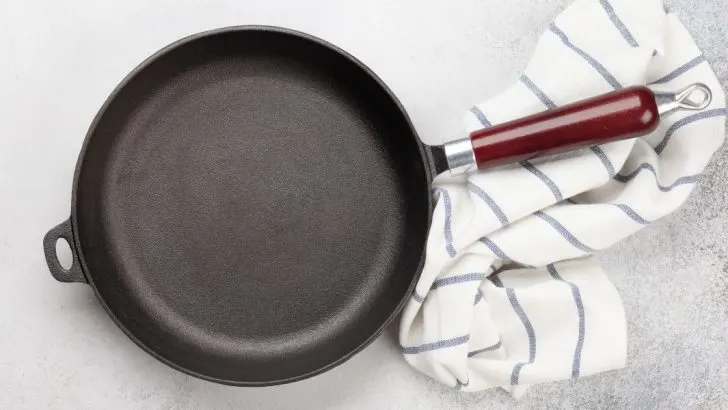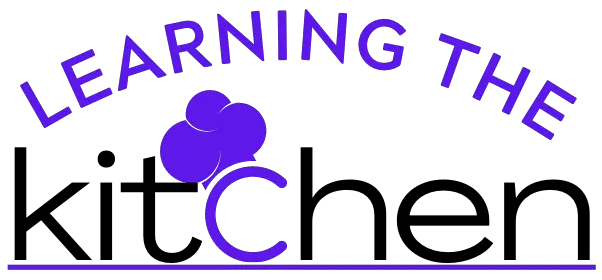If you want to buy the most important kitchen essentials, go ahead and put a frying pan at the top of your list. I don’t know about you, but I definitely have a favorite frying pan. (The brand I use is Misen by the way!) You can pretty much find me in my kitchen grilling some chicken or making omelets for my family. That’s the great thing about frying pans – they’re incredibly versatile.
So, whether you want the best cookware set for your kitchen or you are just completing your existing cookware collection, here is what you need to know about frying pans.

What is the definition of frying pan?
A frying pan is a pan that is used for frying foods. They are a staple of all of the best cookware sets. Frying pans are typically made of metal and have a flat bottom. The sides of the pan are usually sloped, which allows food to be turned easily.
Frying pans are available in a variety of sizes. This is super helpful if you’re cooking a lot of different foods at once or making a multi-course meal. They can be small enough to fit on a stovetop or large enough to accommodate multiple servings. Frying pans can also be equipped with a lid, which helps to retain heat and prevent splattering.
Most home chefs use frying pans for cooking eggs, bacon, sausage, and pancakes. You can also use them to sear or sauté meats and vegetables. When cooking with a frying pan, it is important to use cooking oil or fat to prevent the food from sticking. Or, you can invest in a high-quality non-stick pan like I did.
I love that with non-stick pans, you can just slide food right off of it onto a plate.
What is the difference between a frying pan and a skillet?
There is no difference between a skillet and a frying pan. The two terms can be used interchangeably. I don’t usually use the word skillet unless I’m referring to a cast-iron skillet. I looked it up, and apparently, skillet is more of a British term, but lots of people use it in North America.
Also, some refer to frying pans with lids as skillets and others say that skillets are simply deeper frying pans. So, go ahead and use them interchangeably. Pick your favorite term and get cooking.
What is the difference between a frying pan and a saucepan?
A saucepan is a type of pot that has a lid and is typically used for simmering or boiling liquids. A frying pan does not have a lid, and it is better suited for cooking foods that need to be browned or seared. Like I mentioned previously, some people call wider pans with a lid a skillet, but there’s a distinct difference with a saucepan.
Think about making a nice, big pot of spaghetti sauce. You’re going to want a deep sauce pan with a lid for that (so you don’t get red sauce on your clothes as it bubbles.) So, saucepan = sauce. Frying pan = frying (or grilling) things.
What are the benefits of using a frying pan?
Frying pans have a number of benefits, including:
- They are versatile and can be used to cook a variety of foods.
- They heat up quickly and evenly, which helps to prevent sticking and burning.
- They are easy to clean, and most are dishwasher safe. (Always check the manufacturer’s suggested cleaning instructions.)
- If they are non-stick, it makes it very easy to cook meals.
What are the differences between a sauté pan and a frying pan?
The main differences between a frying pan and a sauté pan are the shape and size. Frying pans typically have sloped sides, while sauté pans have straight sides.
Both frying pans and sauté pans can be used for similar cooking tasks, such as frying, sautéing, and searing. It all comes down to personal preference when it comes to which pan works best for the meals you like to make.
What makes a frying pan a frying pan?
A frying pan is distinguished by its flat shallow bottom and sloped sides. This design allows for easy turning of food. Frying pans are also available in a variety of sizes, which makes them versatile for different cooking tasks. Additionally, some frying pans come with a lid, which helps to retain heat and prevent splattering.
With a frying pan, you can do as the name says and fry food. For example, you can batter and fry chicken or fish in a frying pan. However, many people use it for a variety of cooking tasks other than frying, like grilling meat or heating up vegetables.
What is a frying pan called in America?
In America, a frying pan is called a frying pan! It’s also called a skillet, depending on your preference. As mentioned previously, they really are interchangeable terms.
Can I use a sauté pan as a frying pan?
Yes! A sauté pan can also be used as a frying pan. The main difference between a sauté pan and a frying pan is the shape of the sides. Sauté pans have straight sides, while frying pans have sloped sides. This design allows for easy turning of food.
Home cooks can use sauté pans and frying pans for similar cooking tasks, such as frying, sautéing, and searing. Both pans can come equipped with a lid, which helps to retain heat and prevent splattering.
Really, either one can do the job. Unless you are very picky about only specific pans for specific tasks, most home cooks would do great with either a sauté pan or a frying pan.
What is the best material for a frying pan?
The best material for a frying pan depends on your needs. If you’re looking for a durable option that can withstand high heat, then cast iron or stainless steel are good choices.
The problem with cast iron is it’s extremely heavy and you also have to hand wash it. The pro is that cast iron can quite literally last through several generations. It’s that durable. For those reasons, it’s a good idea to keep at least one cast iron skillet your kitchen cookware collection. However, a stainless steel frying pan might be better for your everyday needs.
Also, if you’re looking for a lighter-weight option, then aluminum is a good choice. Nonstick frying pans are also available, but they may not be as durable as other options. Plus, when the nonstick coating flakes or chips, you need to throw it out.
What is the best size for a frying pan?
The best size for a frying pan depends on your cooking needs at the time. If you’re cooking for one or two people, then a small frying pan is a good choice. If you’re cooking for a larger group, then a large frying pan is a better choice.
Frying pans are available in a variety of sizes, so you can choose the best option for your needs.
What is a small frying pan called?
A small frying pan is often called an egg pan. Egg pans are small and shallow, which makes them ideal for cooking single eggs. They typically have sloped sides, which allows for easy turning. Most egg pans come with a lid, which helps to retain heat and prevent splattering.
What is a large frying pan called?
A large frying pan is often called a skillet. Skillets are large and shallow, which makes them ideal for cooking multiple items at once.
Do I need a frying pan with a lid?
It depends on your needs. If you’re going to be cooking items that splatter, then a frying pan with a lid is a good choice. A lid will help to retain heat and prevent splattering. If you’re only going to be cooking small items, then a frying pan without a lid is a better choice. A splatter guard can also be a great kitchen essential, so you don’t get grease everywhere like when cooking bacon.
Don’t forget you can also wear an apron while cooking if you are concerned about protecting your clothes.
What is another word for frying pan?
Another word for frying pan is a skillet. Some other ones are griddle, wok, fryer, and frypan. Ultimately they can be used in similar ways.
What is the healthiest frying pan to use?
The healthiest frying pan we have used is the Carote granite frying pan. You can read our Carote frying pan review here.
Is sauté the same as frying?
No, sautéing is different than frying. Frying is a cooking method that involves submerging food in hot oil. Sautéing is a cooking method that involves cooking food in a small amount of fat using direct heat.
How big is a frying pan?
Frying pans come in a variety of sizes, but the most common size is 10 inches. Smaller pans are also available, some as low as five inches. These are often called mini frying pans. There are also larger pans up to 12 inches. The size of the pan you need depends on your needs.
What type of pan do chefs use?
Chefs use a variety of different pans, depending on the dish they are preparing. For example, a chef might use a sauté pan for stir-frying or a saucepan for boiling. They use a variety of materials too, such as cast iron, stainless steel, copper, nonstick, and aluminum. Sometimes, specialty foods require specialty pans like woks and paella pans. However, most home cooks use regular skillets, and they work just fine.

How Many Frying Pans Do I Need in My Kitchen?
Now you know everything about frying pans, including some other names they go by. Do you want to know how many you need?
This really depends on how much you like to cook and how big your kitchen is. It’s nice to have a couple of different options depending on the type of food you like to make. My advice is to try out a couple different brands over time, find the one you like best, and buy three different sizes.
That way, no matter what your cooking needs are, you should have a frying pan on hand to get the job done.




